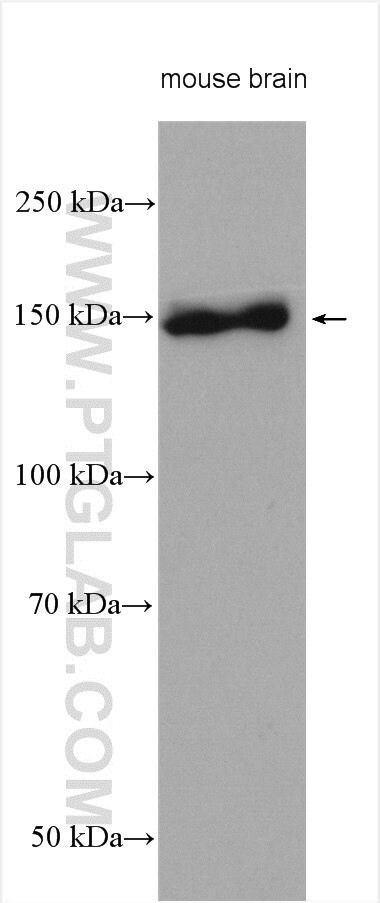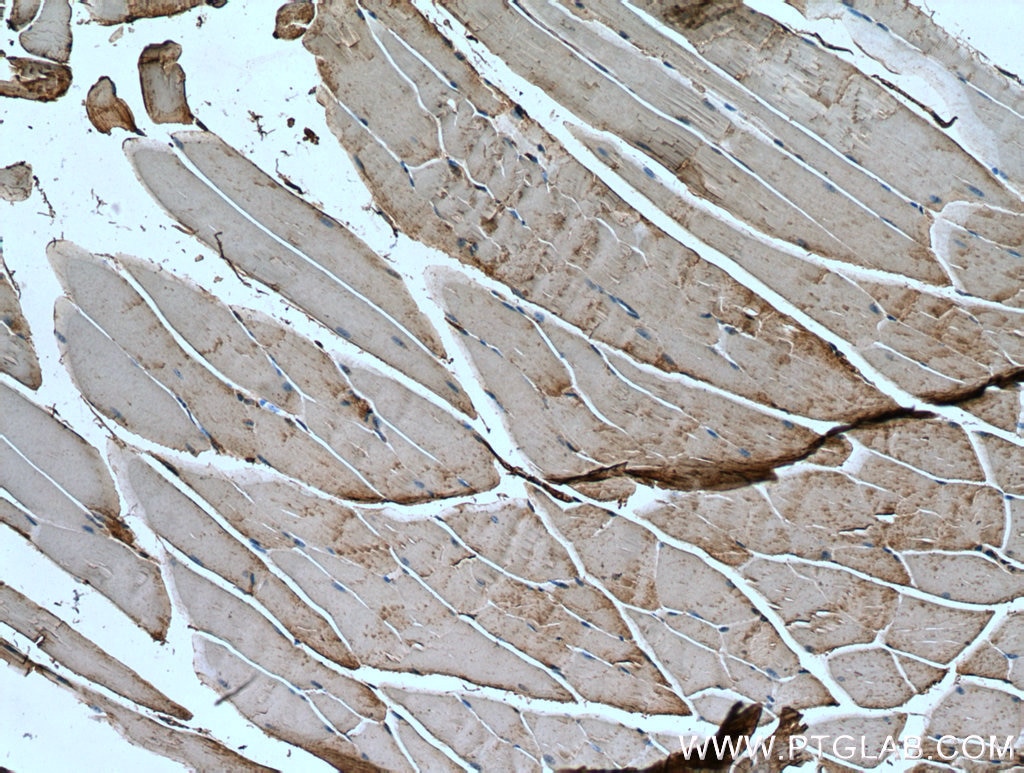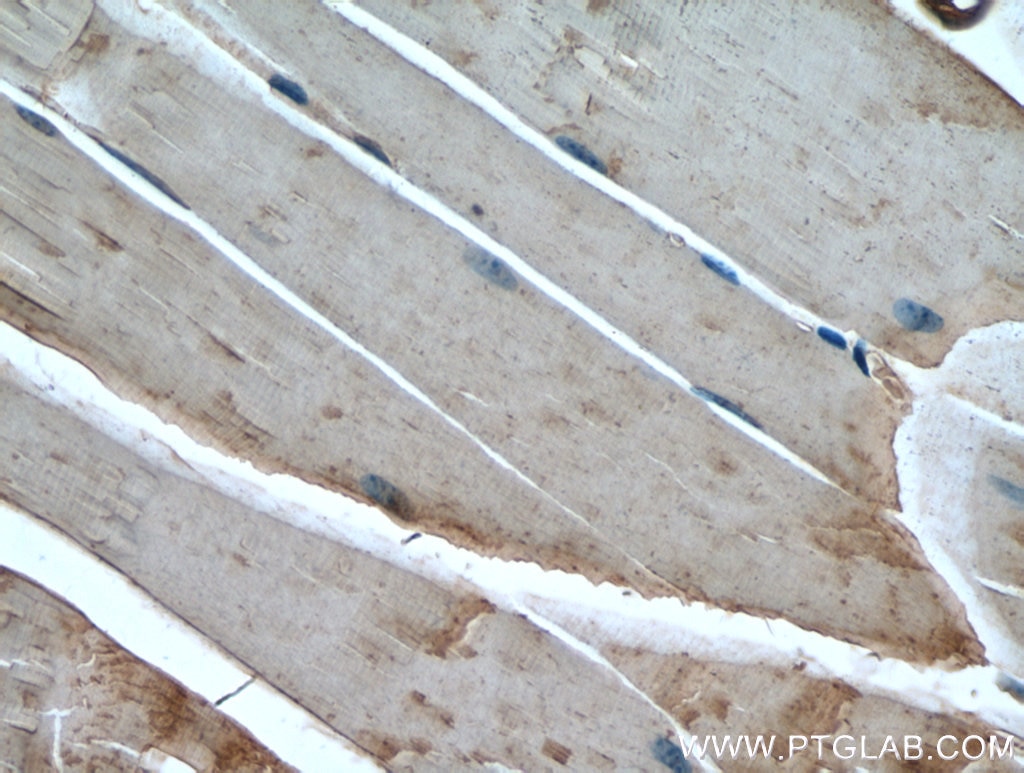IRS2 Polyklonaler Antikörper
IRS2 Polyklonal Antikörper für WB, IHC, ELISA
Wirt / Isotyp
Kaninchen / IgG
Getestete Reaktivität
human, Maus und mehr (1)
Anwendung
WB, IHC, IF, ELISA
Konjugation
Unkonjugiert
Kat-Nr. : 20702-1-AP
Synonyme
Geprüfte Anwendungen
| Erfolgreiche Detektion in WB | Maushirngewebe |
| Erfolgreiche Detektion in IHC | Maus-Skelettmuskelgewebe Hinweis: Antigendemaskierung mit TE-Puffer pH 9,0 empfohlen. (*) Wahlweise kann die Antigendemaskierung auch mit Citratpuffer pH 6,0 erfolgen. |
Empfohlene Verdünnung
| Anwendung | Verdünnung |
|---|---|
| Western Blot (WB) | WB : 1:500-1:1000 |
| Immunhistochemie (IHC) | IHC : 1:50-1:500 |
| It is recommended that this reagent should be titrated in each testing system to obtain optimal results. | |
| Sample-dependent, check data in validation data gallery | |
Veröffentlichte Anwendungen
| KD/KO | See 1 publications below |
| WB | See 11 publications below |
| IF | See 2 publications below |
Produktinformation
20702-1-AP bindet in WB, IHC, IF, ELISA IRS2 und zeigt Reaktivität mit human, Maus
| Getestete Reaktivität | human, Maus |
| In Publikationen genannte Reaktivität | human, Maus, Ratte |
| Wirt / Isotyp | Kaninchen / IgG |
| Klonalität | Polyklonal |
| Typ | Antikörper |
| Immunogen | Peptid |
| Vollständiger Name | IRS2 |
| Berechnetes Molekulargewicht | 137 kDa |
| Beobachtetes Molekulargewicht | 150-185 kDa |
| GenBank-Zugangsnummer | NM_003749 |
| Gene symbol | IRS2 |
| Gene ID (NCBI) | 8660 |
| Konjugation | Unkonjugiert |
| Form | Liquid |
| Reinigungsmethode | Antigen-Affinitätsreinigung |
| Lagerungspuffer | PBS with 0.02% sodium azide and 50% glycerol |
| Lagerungsbedingungen | Bei -20°C lagern. Nach dem Versand ein Jahr lang stabil Aliquotieren ist bei -20oC Lagerung nicht notwendig. 20ul Größen enthalten 0,1% BSA. |
Hintergrundinformationen
The family of INS receptor substrates (IRS) consists of four proteins (IRS-1-IRS-4), which were initially characterized as typical cytosolic adaptor proteins involved in INS receptor (IR) and INS-like growth factor I receptor (IGF-IR) signaling. Impaired glucose tolerance and INS resistance, and thus type 2 diabetes were demonstrated in Irs2 knockout mice. In vivo data also indicated that he regulation of beta-cell mass involves IRS2, while IRS1 is only required for proper INS production in beta-cells. IRS2, like IRS1, has a predicted molecular weight of 137 kDa, however, as a result of its extensive serine phosphorylation it separates on a SDS-PAGE as a band of approximately 150-185 kDa.
Protokolle
| PRODUKTSPEZIFISCHE PROTOKOLLE | |
|---|---|
| WB protocol for IRS2 antibody 20702-1-AP | Protokoll herunterladen |
| IHC protocol for IRS2 antibody 20702-1-AP | Protokoll herunterladenl |
| STANDARD-PROTOKOLLE | |
|---|---|
| Klicken Sie hier, um unsere Standardprotokolle anzuzeigen |
Publikationen
| Species | Application | Title |
|---|---|---|
Oxid Med Cell Longev Microbiota from Exercise Mice Counteracts High-Fat High-Cholesterol Diet-Induced Cognitive Impairment in C57BL/6 Mice | ||
Sci Rep TCF7L2 involvement in estradiol- and progesterone-modulated islet and hepatic glucose homeostasis. | ||
Int J Biol Sci CircFAT1 Promotes Lung Adenocarcinoma Progression by Sequestering miR-7 from Repressing IRS2-ERK-mediated CCND1 Expression. | ||
Food Funct Elucidation of the interaction effect between dietary fiber and bound polyphenol components on the anti-hyperglycemic activity of tea residue dietary fiber. | ||
Heliyon The effect of PINK1/Parkin pathway on glucose homeostasis imbalance induced by tacrolimus in mouse livers | ||
Obesity (Silver Spring) MiR-195 promotes pancreatic β-cell dedifferentiation by targeting Mfn2 and impairing Pi3k/Akt signaling in type 2 diabetes. |




